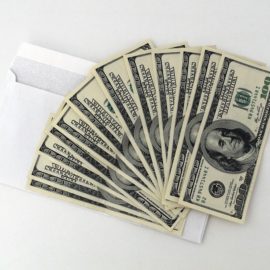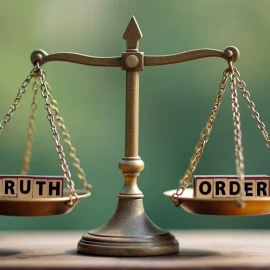

This article is an excerpt from the Shortform book guide to "American Prometheus" by Kai Bird and Martin Sherwin. Shortform has the world's best summaries and analyses of books you should be reading.
Like this article? Sign up for a free trial here.
Why did J. Robert Oppenheimer participate in the development of the atomic bomb? What did he do after the war? Did his attitude about the Manhattan Project ever change?
American Prometheus, a book by writers Kai Bird and Martin Sherwin, provides a comprehensive look at scientist J. Robert Oppenheimer. A historical figure best known for developing the atomic bomb that wrought destruction on Japan in World War II, his broader and deeper story is told in this biography.
Continue reading for our American Prometheus book overview.
American Prometheus Book Overview
According to Bird and Sherwin, Oppenheimer represents a modern-day Prometheus, the Greek Titan eternally punished for stealing fire from the gods and imparting it to humanity. Although the authors dedicate much of their 2006 book American Prometheus to Oppenheimer’s work on the bomb, they also seek to shed light on the lesser-known person behind the bomb, detailing his evolution from adolescent activist to eventual political martyr.
(Shortform note: Although Oppenheimer may have been a lesser-known historical figure in 2006, American Prometheus’s widespread success has changed that. In addition to winning the 2006 Pulitzer Prize for Biography, American Prometheus gained broad acclaim through Oppenheimer, Christopher Nolan’s 2023 adaptation of the biography to film. Because of the American Prometheus book and Nolan’s film, Oppenheimer [who died in 1967] is a household name whose story is known by millions.)
Bird and Sherwin’s complementary backgrounds shape different features of American Prometheus, a project that took over 25 years to complete. On one hand, Bird’s experience as the author of two prior biographies is evident in the book’s organization of historical facts around a coherent narrative. On the other hand, Sherwin’s work as a historian of nuclear weapons informs their discussion of various historical documents relating to Oppenheimer, including FBI files, interviews, and private journals.
We’ll first examine Bird and Sherwin’s presentation of Oppenheimer’s life before the bomb, outlining his journey from an unstable student to a politically active young adult. Next, we’ll discuss Oppenheimer’s role in developing the atomic bomb at the Manhattan Project, focusing especially on his justifications for creating and using the bomb. We’ll then consider Oppenheimer’s transformation following World War II, analyzing the politically motivated security hearing that saw him lose his security clearance. To conclude, we’ll discuss Oppenheimer’s life after he lost his security clearance.
Oppenheimer’s Life Before Developing the Atom Bomb
Though most historical accounts focus on Oppenheimer’s work on the atomic bomb, Bird and Sherwin suggest that Oppenheimer’s adolescence provides context for understanding his views and decisions later in life. They argue that Oppenheimer’s adolescent years were marked by emotional instability that eventually gave way to committed left-wing political activism. We’ll first discuss Oppenheimer’s struggles with mental illness in his youth, followed by his activism that led to allegations of Communist Party membership.
Adolescent Emotional Instability
According to Bird and Sherwin, Oppenheimer’s adolescence and early adulthood were marked by severe emotional instability. Specifically, they contend that Oppenheimer suffered from chronic depression and emotional breakdowns, only to recover in his mid-20s.
They note that, according to Oppenheimer’s friend and Harvard University classmate Paul Horgan, Oppenheimer was prone to multiday depressive episodes at Harvard. During these episodes, he became increasingly reclusive and unavailable to even his closest friends. This emotional volatility, Bird and Sherwin argue, grew even worse during Oppenheimer’s graduate studies at the University of Cambridge in 1925. While there, Oppenheimer allegedly attempted to poison his tutor, whom he was upset with, by leaving a poisoned apple on his desk—an allegation that would nearly result in Oppenheimer’s expulsion from Cambridge.
As Bird and Sherwin relate, Oppenheimer was allowed to remain a student at Cambridge on the condition that he undergo psychoanalysis (a form of therapy that seeks to uncover and address the unconscious roots of our behavior). However, although Oppenheimer was diagnosed with dementia praecox—what’s now known as schizophrenia—the psychoanalysis proved unhelpful. Instead, Bird and Sherwin write, Oppenheimer cited existentialist literature and its emphasis on introspection as the catalyst for improving his mental health.
Oppenheimer’s Early Success in Theoretical Physics
Bird and Sherwin write that, after Oppenheimer’s mental health improved, he enjoyed great success while studying theoretical physics. First, Oppenheimer moved to The University of Göttingen to study with the eminent physicist Max Born, who supervised his doctoral dissertation. There, Oppenheimer published influential work on the burgeoning field of quantum mechanics—he even copublished a paper with Born on the “Born-Oppenheimer approximation,” deemed a key development in quantum mechanics.
Later, in 1928 Oppenheimer accepted a professorship at the University of California, Berkeley, where he spent the next decade turning Berkeley into America’s foremost theoretical physics powerhouse. He continued publishing crucial work in theoretical physics, even mathematically predicting the existence of black holes in a coauthored paper in 1939.
Early Political Views and Activism
As Oppenheimer began his academic career, he became increasingly politically active—a development foreshadowed by his membership in the Student Liberal Club at Harvard in 1922. As Bird and Sherwin argue, Oppenheimer consistently supported progressive causes throughout the 1930s, a fact that contributed to accusations of Communist activities (accusations that haunted him later in life).
Bird and Sherwin note that, owing to economic turmoil following the Great Depression, dockworkers in Berkeley, California—Oppenheimer’s home at the time—started an 83-day strike that upended California’s economy. To show his support, Oppenheimer and his students attended left-wing rallies that celebrated the striking dockworkers. This development, Bird and Sherwin suggest, foreshadowed Oppenheimer’s later support for unions: He became an active member of the East Bay Teachers’ Union in the late 1930s, one of the few Berkeley academics to do so.
In addition to supporting workers’ rights, Oppenheimer became an active champion of the Spanish Republic—the democratically elected Republican Government that was under attack from fascist militants. According to Bird and Sherwin, Oppenheimer was documented as donating about $1,000 annually (around $20,000 in today’s money) in the late 1930s to the Spanish Republican cause. Crucially, Oppenheimer donated this money via Communist Party chapters in America because the Communist Party was directly assisting the Spanish Republic.
Alleged Communist Party Membership
Because Oppenheimer worked closely with members of the Communist Party, many of his detractors alleged he was a Communist Party member himself. Against this allegation, Bird and Sherwin contend that although Oppenheimer’s political views often aligned with Communist Party views, he was never a formal member.
In defense of this claim, Bird and Sherwin cite interviews with several Communist Party members that Oppenheimer had befriended—these friends reported that, although Oppenheimer often socialized with Communist Party members, he never paid dues to those in charge of Party finances, which members were required to do. Even more importantly, these friends claimed Oppenheimer was never subject to Party discipline, which would have required him to stop reading many of his favorite intellectuals, such as Freud and Hemingway.
Nonetheless, Bird and Sherwin acknowledge that certain Party members, like Oppenheimer’s friend and fellow Berkeley professor Haakon Chevalier, believed Oppenheimer was a Party member, citing his regular visits to Party meetings and his support of progressive political causes. Others pointed to Oppenheimer’s intimate relationships with Party members—Oppenheimer had a relationship with Jean Tatlock, a committed Party member, between 1936 and 1939, and his wife Kitty was a former Party member herself. But Bird and Sherwin argue these friends were likely mistaken by Oppenheimer’s close proximity to the Party, which is distinct from Party membership.
The Development of the Atom Bomb
Bird and Sherwin contend that Oppenheimer’s interest in a broad range of progressive causes, from labor unions to the Spanish revolution, was upended by one event: Japan’s bombing of Pearl Harbor in December 1941. Rather than continue investing in these causes, Oppenheimer shifted his focus singularly toward the impending war with Germany and the other Axis powers (Japan and Italy).
The US government was initially reluctant to include Oppenheimer in the bomb project because of his past political associations. However, in 1941 Oppenheimer’s colleague at Berkeley, the renowned experimental physicist Ernest Lawrence, vouched for Oppenheimer and earned him an invite to early government meetings about the bomb. Then, in 1942 the government’s committee on nuclear weapons made Oppenheimer the leader of fast-neutron research, a key component of developing the atomic bomb. Having shown his worth, Oppenheimer was nominated by General Leslie Groves to direct the Manhattan Project (the US’s nuclear weapons project) in October 1942.
We’ll examine Oppenheimer’s tenure as head of the Manhattan Project, focusing on three key areas: Oppenheimer’s initial justification for developing the atomic bomb, his evolving views on the bomb throughout World War II, and finally his arguments for the permissibility of bombing Japan.
Initial Rationale for Developing the Bomb
Despite the grave risks of creating a weapon of mass destruction, Oppenheimer approached his work as director of the Manhattan Project with verve. According to Bird and Sherwin, Oppenheimer did so because he worried that Nazi Germany would develop nuclear weapons before the US, making them effectively unstoppable.
Bird and Sherwin point out that Oppenheimer’s worry was shared by members of the US military and scientific community in the early 1940s. After all, German scientists were the first to discover that uranium atoms could be split in 1939—the key behind so-called “fission” bombs—and rumors abounded that Germany had taken control of Czechoslovakia’s uranium mines to acquire the uranium necessary for a bomb.
As for Oppenheimer himself, Bird and Sherwin cite many discussions with his friends showing the extent of his concern. For example, Hungarian-American physicist Edward Teller, who worked closely with Oppenheimer on the Manhattan Project, recalled Oppenheimer’s sentiment that developing an atomic bomb was necessary to defeat Hitler’s Germany.
Evolving Attitude as the War Progressed
Bird and Sherwin maintain that developments in the war led Oppenheimer to rethink his rationale for creating the atomic bomb. They relate that, by late 1944, it was evident that Germany was on the brink of defeat, making Oppenheimer’s original motivation moot. Consequently, Oppenheimer instead reasoned that the importance of transparency justified creating and testing the bomb, as the world deserved to know that nuclear weapons were possible.
According to Bird and Sherwin, Oppenheimer explained his reasoning in a March 1945 meeting of Manhattan Project scientists. As experimental physicist Robert Wilson recalled, Oppenheimer argued that, if the development of the bomb ceased, it would likely become classified military information. Because this option would leave inside knowledge about nuclear weapons in US hands alone, Oppenheimer instead thought the scientists were obligated to finish creating the bomb, so the rest of the world could understand the true impact nuclear weapons could have on future wars.
As Wilson and others present at the Manhattan Project meeting conveyed, Oppenheimer’s speech convinced his fellow scientists to complete the development of the atomic bomb. Several months later, on July 16, 1945—about three months after Hitler committed suicide and Germany surrendered—a successful test of the atomic bomb, known as Trinity, took place with the Manhattan Project’s scientists watching.
Oppenheimer’s Views on Bombing Japan
Bird and Sherwin relate that, even before Trinity displayed the atomic bomb’s might, the US military was considering using the bombs on Japan, the final Axis power standing in World War II. Moreover, they note that Oppenheimer actively supported the decision to use the atomic bomb against Japan and even acquiesced to the military’s proposed targeting of civilians.
The clearest statement of Oppenheimer’s views, they write, stems from the Scientific Panel’s June 1945 memorandum to the Interim Committee (a military group advising the secretary of war). In this memorandum, Oppenheimer explicitly endorsed the military use of the bomb against Japan. He reasoned that one decisive bombing of Japan could serve as an effective deterrent against all future wars, thus justifying the bombing.
However, Oppenheimer differed from the military when it came to cooperating with foreign powers. Bird and Sherwin point out that, along with his other panel members, Oppenheimer urged transparency with other international powers—including the Soviet Union. He reasoned that secrecy about the US’s nuclear weapons could spark a deadly arms race, and radical candor was the best route to avoiding this arms race.
Japan’s Desire to Surrender
Though Oppenheimer supported using the bomb against Japan, he lacked access to crucial information that, Bird and Sherwin suggest, might have changed his mind. In particular, Oppenheimer didn’t know that Japan was on the verge of surrendering, assuming agreeable terms of surrender could be reached.
Bird and Sherwin note that this fact is now well-known by historians: By May 1945, the US military had intercepted messages from Japan that expressed a desire to surrender on fair terms. For this reason, high-ranking military officials in Washington were actively discussing ways to induce a Japanese surrender. In July 1945, President Truman even acknowledged in his private journal that, according to US intelligence, Japan was actively seeking peace with the Allied forces.
The Aftermath of the Atom Bomb
Despite intelligence about Japan’s desire to surrender, President Truman chose to use the atomic bomb on Japan, bombing Hiroshima on August 6, 1945, and Nagasaki on August 9. According to Bird and Sherwin, Oppenheimer’s initial reaction to the bombings was ambivalent; he proudly congratulated his team following the first bombing, but friends report him consumed with qualms. In turn, Oppenheimer became an increasingly outspoken advocate for nuclear regulation after the bombing, earning him powerful political opponents who sought to excommunicate him.
We’ll dig deeper into Oppenheimer’s life in the wake of the bombing. Bird and Sherwin suggest that this phase of Oppenheimer’s life was marked by his consistent advocacy for transparency and regulation in nuclear policy, followed by a politically motivated hearing that ended in Oppenheimer’s security clearance being revoked, effectively ousting him from the upper echelon of US government.
Advocacy for Transparency and International Regulation
Following the bombings in Hiroshima and Nagasaki, Oppenheimer became increasingly vocal about atomic policy. As Bird and Sherwin relate, Oppenheimer’s proposed nuclear policy had two primary recommendations: The world should create an international commission to regulate nuclear weapons and scientists from all countries should speak freely with one another.
Bird and Sherwin write that Oppenheimer endorsed international regulation of nuclear energy in the Acheson-Lilienthal report to President Truman, a report written on behalf of Truman’s nuclear advisory committee in 1946. As the report’s author, Oppenheimer argued that all countries should submit to an international authority. He reasoned that an international body provided the best chance of avoiding nuclear war, as it would prohibit rogue nations from developing further nuclear weapons on their own.
Meanwhile, Bird and Sherwin say, in a November 1945 speech to Los Alamos scientists, Oppenheimer proposed creating a system that would allow different countries’ scientists to communicate openly. Such a system, he believed, would prevent countries from harboring secrets that could encourage a deadly nuclear arms race.
Oppenheimer’s Unsuccessful Attempts to Influence Nuclear Policy
Although Oppenheimer became an outspoken advocate of nuclear regulation, Bird and Sherwin maintain that he failed to successfully influence US nuclear policy. These failures were most obvious in two instances: Oppenheimer’s meeting with Truman, and the Baruch Plan formed in response to Oppenheimer’s recommendations in the Acheson-Lilienthal Report.
Oppenheimer’s Meeting With Truman
Bird and Sherwin relate that, in October 1945, Oppenheimer earned a meeting with President Truman, providing him the opportunity to express his concerns about a potential arms race with the Soviet Union. However, Oppenheimer didn’t take full advantage of this opportunity, instead regretfully telling Truman “I feel I have blood on my hands”—a statement Truman took as a sign of weakness. Later, Truman allegedly commented, “I don’t want to see that son-of-a-bitch in this office ever again.”
The Baruch Plan and the Acheson-Lilienthal Report
Bird and Sherwin also note that, as mentioned above, Oppenheimer was a key author of the Acheson-Lilienthal Report directed to President Truman. This sweeping report recommended full transparency with other nations and developing an international committee that reduced individual nations’ freedom to create nuclear weapons.
But, as Bird and Sherwin relate, President Truman’s representative to the United Nations (UN), Bernard Baruch, gutted the proposal. Instead, Baruch submitted his own plan to the UN that, according to Bird and Sherwin, specifically targeted the Soviet Union by rescinding their veto powers and stipulating that any violation of the agreement be punished with a nuclear bombing. In turn, the Soviets rejected Baruch’s plan, ultimately causing UN talks to stall and setting the stage for the coming Cold War.
The 1954 Security Clearance Hearing
Though Oppenheimer had spearheaded the creation of the atomic bomb and served on various committees consulting the government on nuclear policy, he was often targeted by his political enemies after the atomic bomb for his past connections to communism. According to Bird and Sherwin, the animosity toward Oppenheimer culminated in December 1953, when he learned that the Atomic Energy Commission (AEC) intended to revoke his security clearance.
The movement to revoke Oppenheimer’s security clearance, Bird and Sherwin argue, was led by Lewis Strauss—the chairman of the AEC. Bird and Sherwin write that Strauss’s disdain of Oppenheimer was deep-seated; in his 1949 testimony before the Joint Committee on Atomic Energy, Oppenheimer had embarrassed Strauss by sharply refuting Strauss’s testimony about the importance of isotopes in developing nuclear weapons.
After many confrontations with Oppenheimer about nuclear policy in the early 1950s, Strauss began plotting to get Oppenheimer’s security clearance revoked. According to Bird and Sherwin, he first contacted William Borden, the AEC’s staff director who felt similarly about Oppenheimer and provided Borden access to Oppenheimer’s security file. On the basis of this file, Strauss helped Borden compose a brief alleging Oppenheimer was likely a Soviet agent. Bird and Sherwin say that this brief led to an FBI report that convinced the Eisenhower administration to conduct an AEC hearing to revoke Oppenheimer’s security clearance.
Strauss’s Illicit Tactics Throughout the Hearing
As the AEC’s chairman, Strauss had the authority to decide the three members of the AEC panel that would judge Oppenheimer. In addition to this authority, Bird and Sherwin argue, Strauss consistently employed illicit tactics throughout the hearing to predetermine the verdict against Oppenheimer.
Tactic #1: Biasing the Board
First, Bird and Sherwin point out that even before the hearing, Strauss actively biased the panel against Oppenheimer. They write that Strauss arranged for the panel members to read Oppenheimer’s FBI security file before the hearing—in the presence of prosecuting attorney Roger Robb, at that. Without Oppenheimer’s defense present, Robb personally guided the board through the most damning portions of Oppenheimer’s security file. As Bird and Sherwin relate, this violated the basic legal principle of tabula rasa—that juries approach trials with a clean slate and no preconceived opinions of the defendant.
Tactic #2: Handicapping Oppenheimer’s Lawyers
Further, Bird and Sherwin observe that Strauss handicapped Oppenheimer’s lawyers by denying them a security clearance while providing one for the prosecuting lawyers. As a result, Oppenheimer’s lawyers often lacked access to the evidence presented to the panel, making it impossible for them to respond to the prosecution’s accusations.
Tactic #3: Illegal FBI Wiretaps
Finally, Bird and Sherwin write that Strauss had access to illegal FBI wiretaps of Oppenheimer’s conversations with his lawyers. As a result, Strauss could predict the defense lawyers’ legal tactics and relay them to Robb, the prosecuting attorney. These illegal wiretaps not only violated attorney-client privilege but also provided Robb with a strategic edge throughout the hearing.
The Presentation of the Chevalier Incident
Bird and Sherwin contend that, in addition to underhanded tricks, the prosecution relied heavily on Oppenheimer’s testimony about the “Chevalier incident,” a conversation between Oppenheimer and Haakon Chevalier, his close friend and fellow Berkeley faculty member, in late 1942.
Months later, in August 1943, Oppenheimer first gave an account of this conversation to Colonel Boris Pash. Oppenheimer told Pash that he and two other scientists had been approached by an intermediary (later revealed as Chevalier) who was friends with George Eltenton, a physicist with connections to the Soviet Union. Per Oppenheimer’s testimony, this intermediary told Oppenheimer and the other scientists that Eltenton hoped to relay information about the Manhattan Project to the Soviets, a suggestion Oppenheimer immediately called treasonous.
Later, in June 1946, FBI agents simultaneously interviewed Eltenton and Chevalier about Chevalier’s discussion with Oppenheimer in 1943, giving them no time to coordinate their answers. They both corroborated Oppenheimer’s previous account, with one glaring exception: They both denied having approached two other scientists, as Oppenheimer claimed. Later, in September 1946, FBI agents interviewed Oppenheimer himself, who admitted to fabricating elements of his original account to protect Chevalier’s identity.
Bird and Sherwin point out that, in the 1954 hearing, Oppenheimer’s prior false testimony proved damning. Robb compelled Oppenheimer to admit to the AEC’s panel that he had lied to the FBI and waited eight months to disclose a conversation of crucial security information. Moreover, in the heat of the examination, Robb induced Oppenheimer to call himself “an idiot” who told “a whole fabrication and tissue of lies.” This testimony, Bird and Sherwin argue, greatly discredited Oppenheimer in the eyes of the panel.
The AEC Panel’s Ruling
Strauss’s efforts to revoke Oppenheimer’s security clearance proved successful in May 1954: The panel voted two to one to revoke Oppenheimer’s security clearance, deeming Oppenheimer a security risk (though affirming his loyalty to the US). Bird and Sherwin argue that the dissent, written by Ward Evans, captured the true nature of the hearing: It pointed out that nearly all the evidence in the hearing was known in 1947 when Oppenheimer’s security clearance was renewed by the AEC. For this reason, Evans thought there was no justification for revoking Oppenheimer’s clearance years later. And, although the ruling was technically a recommendation, Bird and Sherwin note that it was ratified by AEC commissioners in a four-to-one vote in June 1954.
Oppenheimer’s Life Post-Hearing
Bird and Sherwin contend that the loss of Oppenheimer’s security clearance signified his fall from grace in the eyes of politicians and much of the American public. They argue that Oppenheimer effectively underwent a transformation after the security hearing: He was no longer an inside adviser on nuclear policy, but instead an exiled intellectual. We’ll discuss Bird and Sherwin’s account of this transition followed by Oppenheimer’s later political rehabilitation by the Kennedy administration.
The Shift from Political Insider to Public Intellectual
According to Bird and Sherwin, Oppenheimer’s public activism became increasingly selective in the years following his security hearing. They argue that he became reticent to speak about nuclear policy and instead spoke more generally on the interaction between science and culture.
However, the authors point out that, regarding other topics, Oppenheimer spoke freely. One year after the hearing, for instance, Oppenheimer published eight essays urging scientists to be transparent with the public. These publications, Bird and Sherwin maintain, show that Oppenheimer remained keenly concerned about broader cultural issues, though he balanced this concern with his wish to appear a faithful American.
Oppenheimer’s Political Rehabilitation
Bird and Sherwin further argue that, although Oppenheimer never regained his security clearance, the Kennedy Administration rehabilitated his political image by awarding him the prestigious Enrico Fermi Prize for public service. According to Bird and Sherwin, this 1963 award was highly symbolic: It represented Democrats’ belief that Oppenheimer was the victim of Republicans’ politically charged attacks the previous decade. And though Oppenheimer remained a divisive political figure, the award signified a shift in his favor just four years before his death.

———End of Preview———
Like what you just read? Read the rest of the world's best book summary and analysis of Kai Bird and Martin Sherwin's "American Prometheus" at Shortform.
Here's what you'll find in our full American Prometheus summary:
- The biography of J. Robert Oppenheimer that inspired the movie Oppenheimer
- Oppenheimer's early life and mental health struggles
- Oppenheimer's role in developing the atomic bomb and the following hearing






